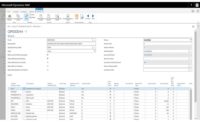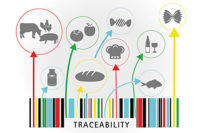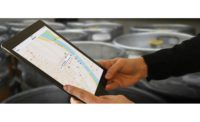From the moment an ingredient comes through the door of a manufacturing facility, to the moment the finished product is delivered to the store, rapid traceability is a must. Thankfully, new technology makes error-free traceability easy.
Our paperless future
More companies continue to go paperless, which improves both inventory control and traceability.
“When technology replaces paper, there is a data trail. Misplaced receiving slips, delivery slips and inventory adjustments are a thing of the past; every entry is stored in your database to refer to when necessary,” says Wayne Ortner, product advisor, FlexiBake, Vancouver, British Columbia.
“By going paperless, goods labeled with bar codes or cases tagged with RFID tags, for example, flow freely through the supply chain automatically, without added effort required to track goods using document-tracking processes. Distribution trend information, and distribution efficiency, can also be tracked,” says John Ashodian, logistics automation marketing manager, SICK, Minneapolis. “By being able to track a single item or case of items, good can be located quickly and routed properly for maximum efficiency and transparency.”
Component-type single-scan point readers help users validate bar code placement or track items on conveyor and sortation systems. Intelligent sensor products can detect and measure items.
“We offer more sophisticated, integrated systems that utilize multiple vision and laser-based scanner components, as well as RFID readers,” says Ashodian. “Dimensioning and weighing devices handle very high-speed sortation and conveying applications for both inbound and outbound goods handling.”
Toolbox Software, Scottsdale, AZ, works with RFID tags, as well. “Each of our items is recorded with a time stamp and batch-ID and directly assigned to a destination. Each stack gets a unique tag with all of the shipping and tracking information. The receiving site scans the tags for further handling instructions, such as picking or cross-docking,” says Ralf Ulmer, president. “Printers which are able to print tags with RFID are in the test phase now for the next level.”
Follow the breadcrumbs
The system from Lowry Solutions, Brighton, MI, acts as an end-to-end system to simplify traceability. “We track lots of raw materials and suppliers arriving at the facility through the manufacturing and packaging process, and out to shipping the finished good in the warehouse,” says Paula Peterson, supply chain solutions consultant.
The solution is very modular. A company can start in an area in its facility that offers the biggest “bang for the buck,” and the solution can scale out to other areas of the facility over time.
Additionally, a feature called “license plating” allows companies to put a unique, serialized number on product, tubs, bins or other containers to track materials at a more-granular level below the lot. The license plate acts much like a VIN on a car and ties historical data to that unique number.
“For example, when moving a tub of raw material to the manufacturing area, all that is needed is to scan the license label on the tub. Our system knows the current location and other critical information about the product. Should an operator try to pick the wrong raw material, our system can stop them and prevent a recall,” adds Peterson.
Through FlexiBake’s purchasing, production, sales and lot tracking modules, manufacturers have complete traceability, from the moment a raw material is received all the way to when the customer receives a finished product.
“Full mock recalls can be completed in under one minute, and include reports with specific inventory to be pulled off shelves,” says Ortner.
FlexiBake understands that most manufacturers require a certain level of traceability, but are also in need of route and delivery management; the company offers its combined equipment bundle to those companies. Ortner notes that the system is flexible enough to accommodate a very wide range of operations.
Evolution of the UPC
The UPC dates back to 1973 and helps support many regulatory compliance requirements for the food industry.
The first step in creating barcodes and assigning unique product identification numbers is to obtain a GS1 Company Prefix, a unique ID number. Then Global Trade Item Numbers (GTINs), found beneath the UPC bar code, are assigned to uniquely identify the company’s products at all item and package levels.
Another type of identifier called a Global Location Number (GLN) is another GS1 industry standard, which can be used to identify the locations of parties involved in business transactions—these can be functional groups within a company, or places that might ship, receive, process or hold inventories.
“With GTINs and GLNs, companies can share product and location information electronically with trading partners,” says Angela Fernandez, vice president, retail grocery and foodservice, GS1 US, Lawrenceville, NJ. “This reduces communication errors, increases the speed of trade transactions and supports real-time product information updates.
“GS1 standards provide traceability by enabling the tracking of end-to-end movement of products through the supply chain, from the original source—manufacturer or grower—to the retail shelf,” continues Fernandez. “With complete supply chain visibility, product recalls can be more efficiently managed in the event of a foodborne illness outbreak or product quality-control issue.”
Regardless of the methods employed, paperless traceability makes reacting in the event of a mishap a snap—and often helps prevent them in the first place.
Tracking the buzz

Select ingredients require a higher level of source traceability and certification, including honey. Some honey is still imported into the U.S. in circumvention of trade laws and—by extension—sometimes quality and safety assurances.
“Imported honey originating from China is being transshipped through other countries to circumvent the U.S. duty. An antibiotic that has been banned in the U.S. has sometimes been found in imported honey originating from China. Other honey has been found to contain added syrups or sweetener extenders that are not made by bees in the hive,” says Gordon Marks, executive director, True Source Honey, Washington, D.C.
True Source Honey Certification was developed to help prevent illegal trade in honey that circumvents U.S. law. About 30 percent of the honey sold in North America is True Source Certified, which provides audits by an internationally recognized third-party firm that certifies the source of the honey, from hive to packer.
“As with any food, when you’re not sure of the origin, you can’t be sure of the quality,” says Marks.








